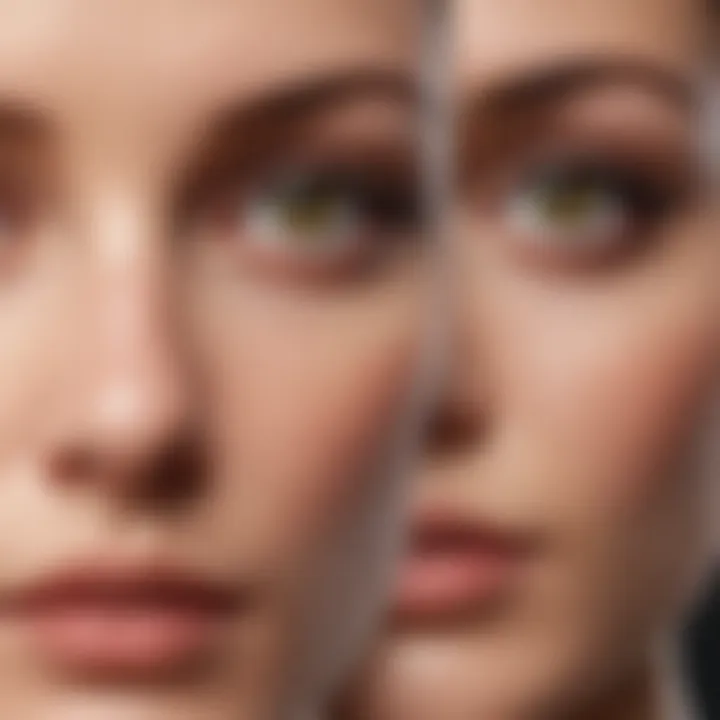Exploring the Best White Eye Primers: A Comprehensive Guide


Intro
In the world of beauty, the significance of eye makeup cannot be understated. For many, it acts as the definitive touch in a complete look. Among the products that stand at the forefront of this artistry is the white eye primer. While it might seem that any primer will suffice, white eye primers possess unique qualities that elevate eye makeup to new heights.
This guide aims to uncover the essential features and benefits of these products, while also spotlighting the best options available on the market today. Whether one is a makeup novice or a seasoned expert, understanding how to use white eye primers effectively can enhance the beauty routine remarkably.
We will explore practical application techniques, delve into various formulations, and ultimately help readers identify which white eye primer aligns best with their specific needs and aesthetic goals.
Understanding White Eye Primers
White eye primers are an essential component in the makeup application process. They serve as a base for eyeshadows and can significantly influence how colors appear on the eyelids. Knowing their role can help optimize makeup routines for those seeking to enhance their aesthetic outcomes. This section will delve into what white eye primers are and the benefits they offer.
Definition and Purpose
White eye primers are specifically designed cosmetic products that create a smooth, even canvas on the eyelids. Their primary function is to improve the visibility of eyeshadow colors, allowing for a true representation of the product on the skin. This ensures that the chosen shades are vibrant and remain consistent throughout the day. By preparing the skin, these primers also aid in combating issues like creasing and fading.
The Advantages of Using a Primer
White eye primers come with several advantages that make them beneficial for makeup application. Below, we explore key reasons why one should consider incorporating them into their routine:
Increased Color Payoff
Increased color payoff is one of the defining traits of white eye primers. When used as a base, these primers help to amplify the richness of eyeshadow pigments. This means that shades can appear more intense and vibrant compared to when applied directly to the lid without a primer. The unique formula of these primers often adheres well to pigments, making the colors pop.
Enhanced Eyeshadow Longevity
Another significant advantage of white eye primers is their ability to extend the wear time of eyeshadows. They provide a barrier between the skin's natural oils and the makeup, effectively reducing the chances of fading or smudging. This aspect is particularly vital for occasions that require makeup to look flawless for extended periods.
Improved Texture and Blendability
Improved texture and blendability is an important facet of using white eye primers. These products create a smooth surface, which facilitates easier application and blending of eyeshadows. The even base allows artists to work with multiple colors without the fear of patchiness. It leads to a more professional finish, ultimately enhancing the overall look of the makeup.
Using a white eye primer elevates your eyeshadow game, ensuring brighter colors and longer-lasting wear.
In summary, understanding white eye primers involves recognizing their definition, purpose, and multitude of advantages. Embracing these products provides benefits such as increased color payoff, enhanced longevity, and improved texture for a seamless makeup application.
Key Features of Quality White Eye Primers
White eye primers play a critical role in the makeup routine, especially for those who desire a flawless finish and vibrant color payoff. Understanding the key features of quality primers can make a significant difference in the overall effectiveness of your makeup. Two main aspects to consider are the texture and consistency, as well as the blendability and drying time. Each factor contributes uniquely to how the primer performs on your skin, affecting the final look.
Texture and Consistency
The texture and consistency of a white eye primer are essential for creating a smooth canvas. A high-quality primer should have a creamy or fluid texture that applies easily without tugging at the skin. This smooth application helps to minimize any fine lines or uneven textures on the eyelids. A water-based or silicone-based primer works well as they offer different finishes and feel.
- Silicone-based primers generally glide onto the skin, providing a matte or velvety finish. They tend to blur imperfections and create an ideal surface for eyeshadows.
- Water-based primers often feel lighter and can be more comfortable for those with sensitive skin. They may provide a dewier finish but can sometimes be less effective at preventing creasing.
A balance between comfort and performance in texture is key. If a primer feels heavy or sticky, it can disrupt the application of eyeshadows, leading to patchiness and inconsistencies.
Blendability and Drying Time


Blendability is another crucial feature. A good primer should allow for seamless blending of eyeshadow without causing it to cling to certain areas. This factor directly impacts your ability to create gradient effects and layered looks.
Moreover, the drying time is also vital. Some primers dry quickly, which can be beneficial for setting your makeup in place. However, if they dry too fast, it may not give enough time to blend shadows properly. It is best to find a primer that has a moderate drying time, allowing for adequate blending while still providing a reliable base that locks in eyeshadow throughout the day.
In summary, understanding the texture and consistency alongside blendability and drying time are fundamental when selecting a white eye primer. These features will enhance the overall makeup look and contribute to lasting results. By choosing a primer that satisfies these key aspects, one can ensure a more polished and vibrant appearance.
Criteria for Choosing the Best White Eye Primer
Selecting the right white eye primer is essential for achieving optimal results in makeup application. Several factors influence the choice, including skin type and intended use. Understanding these criteria helps consumers make informed decisions that better meet their specific needs. This section focuses on the relevance of skin type and purpose as key elements in the selection process.
Skin Type Considerations
Sensitive Skin
Sensitive skin requires gentle products to avoid irritation. Many primers can contain harsh ingredients. Thus, a calming formula is vital. Look for primers that incorporate soothing agents like aloe vera or chamomile. Such options are beneficial because they help in minimizing redness and discomfort. However, some may not provide the required hold for eyeshadow. It is important to test products to ensure comfort and effectiveness.
Oily Skin
Oily skin can affect the longevity of makeup. Primers for oily skin typically contain mattifying agents that control shine. These formulations help to keep eyeshadow from creasing or fading. Choosing products with a lightweight texture is vital to prevent feeling heavy or greasy. However, if too drying, they may cause flaking. Therefore, a balance needs to be found in products targeted for oily skin.
Dry Skin
Dry skin requires hydration to look its best. Primers designed for dry skin often have moisturizing properties that enhance texture. Ingredients like hyaluronic acid can provide necessary hydration. These products are advantageous because they create a smooth base for makeup application. However, they may not have longevity characteristics, thus needing reapplication during the day. Being aware of these factors can guide users toward suitable choices.
Purpose and Occasion
Everyday Use
For daily makeup routines, primers should be versatile and easy to apply. A lightweight formulation is essential, as it provides a natural look while allowing for color payoff. The goal is consistency and long-lasting wear without the weight. Popular choices often include products that are quick to dry and blend seamlessly. However, everyday options may lack the intensity needed for dazzling evening looks.
Special Events
Special events demand a more robust primer because of the need for durability. Formulations should offer higher pigmentation and a strong base. These primers often contain stronger adhesive properties to keep makeup intact throughout the day. While they provide excellent performance, they may feel heavier on the skin. Knowing when to invest in more specialized products can make a significant difference on important occasions.
Top Rated White Eye Primers
The importance of exploring top-rated white eye primers cannot be understated for anyone looking to enhance their makeup application. These primers serve as a foundation for the eyes, ensuring that eyeshadow colors appear vibrant and true to their original shades. It is particularly worth noting that the effectiveness of eye makeup can heavily relies on the quality of the primer used. This section aims to spotlight highly rated white eye primers, detailing their specific benefits and how they contribute positively to the user's makeup experience.
Product Review Overview
In this overview, we will discuss several top-rated white eye primers currently available in the beauty market. Each product is selected based on criterion such as user reviews, ingredients, and overall performance. Understanding these elements helps readers make informed decisions about which product may best suit their needs. It is crucial to remember that the efficacy of a primer can depend on individual preferences, skin type, and the specific look one aims to achieve.
Detailed Analysis of Each Product
Primer A
Primer A is known for its superior blendability and lightweight texture. Many users commend its ability to create a smooth canvas for eyeshadow application. The key characteristic of this primer is its long-lasting formula, which prevents creasing and fading throughout the day, making it a popular choice among makeup enthusiasts.
One unique feature of Primer A is its inclusion of hydrating ingredients which can be advantageous for those with dry skin. However, some users have noted that the formula might not work as well for oily skin types, leading to a potential drawback in certain situations.
Primer B


Primer B has gained popularity due to its matte finish, appealing to those who prefer a more subdued look. This primer's significant contribution to the overall effectiveness of eye makeup lies in its ability to increase color payoff substantially. Makeup artists often recommend it for special occasions where makeup needs to withstand sweat and heat.
A notable advantage of Primer B is its quick-drying formula, which allows users to apply their eyeshadows promptly after. On the downside, this quick-drying effect may catch some users off-guard and could require a bit more finesse during application.
Primer
Primer C stands out with its innovative formulation that combines both hydrating and setting properties. This makes it a versatile option for various skin types. The key characteristic that distinguishes Primer C is its dual function—serving as both a primer and a subtle highlighter for the eyelids. Many users appreciate this feature, as it can simplify their makeup routine.
However, some users may find the highlighter aspect gives an undesirable sheen that might not be suitable for all occasions. Evaluating the specific need and desired affect before committing to this product is advisable.
Application Techniques for Maximum Effectiveness
The way you apply white eye primer greatly influences its effectiveness. Proper application techniques can enhance the longevity of makeup and ensure that colors appear vibrant and true to their form. This section delves into critical elements that contribute to the successful use of white eye primers, emphasizing not just the methods but also the importance of preparation and technique in achieving desired results.
Prepping the Eye Area
Before applying any eye primer, it's essential to prepare the eye area properly. This step lays the groundwork for a flawless application and helps the primer adhere effectively to the skin. Here are some tips to consider:
- Cleanse: Ensure that the eyelids are clean and free from any oil or residue. Use a gentle cleanser that does not irritate the delicate skin around the eyes.
- Moisturize: Apply a lightweight eye cream to the eyelids. This can help to hydrate the skin, preventing it from becoming too dry, which might cause the primer to flake or not spread evenly.
- Settle Your Skin: Allow the moisturizer a moment to absorb fully before moving on to the primer application. Waiting just a few minutes can yield improved results.
Taking these necessary steps increases the chances that the eye primer will perform its best.
Step-by-Step Application Process
A well-executed application process maximizes the effectiveness of white eye primers. Here’s a simple step-by-step guide:
- Use a Clean Brush or Finger: Depending on personal preference, using a clean brush or your fingertip to apply the primer can help. Ensure your guide tool is sanitized.
- Dab, Don't Rub: Apply a small amount of primer to the back of your hand. Then, use your chosen method to dab the primer onto the eyelid. Rubbing can lead to an uneven layer or removing moisture from the skin.
- Spread Evenly: Using a gentle patting motion, spread the primer across the eyelid, ensuring even coverage from the lash line to the brow bone.
- Blend into the Crease: Don't forget the crease of the eye. Bring the primer up slightly into the crease for better color payoff when applying eyeshadow.
- Allow to Set: After application, wait a few moments for the primer to dry completely before applying eyeshadow. This helps to create a smooth canvas and ensures better adherence.
Following this structured approach can significantly contribute to the effectiveness of the product used and prevent common pitfalls. Eventually, the careful application of a white eye primer becomes an integral step in achieving a lasting and vibrant eye makeup look.
Remember: Properly applying a white eye primer can enhance color intensity and prolong the wear of your makeup throughout the day.
Common Mistakes to Avoid
Understanding the missteps that can occur when using white eye primers is critical for achieving the desired effects. Flaws in application can severely affect the overall outcome of the makeup, making this section essential. Recognizing what not to do aids in enhancing one’s makeup routine, allowing for better results and overall satisfaction with the products used.
Using Too Much Product
Applying too much product is a common mistake made by many when it comes to eye primers. It may seem intuitive that a thicker layer would provide better coverage. However, this assumption often leads to a messy and cakey finish. Too much primer can cause the eyeshadow to clump or lose its vibrancy. It can also result in an uneven application that may not hold well throughout the day.
To avoid this, it is crucial to apply a thin layer. A pea-sized amount is often enough to cover the lid. Use your fingers or a brush to evenly spread the product. This ensures a smooth base for eyeshadow. Moreover, this approach allows the eyeshadow to adhere better, maintaining the integrity of color and texture.
Ignoring Skin Type
Another significant mistake is overlooking skin type when selecting and applying white eye primers. Different skin types react differently to products, and failure to consider this can lead to poor outcomes. For example, those with oily skin may find that a creamier primer can lead to unwanted shine or smudging as the day progresses. Conversely, people with dry skin might require a more moisturizing formula to prevent flakiness.
To mitigate this issue, understanding your skin can guide product choices. If you have sensitive skin, look for hypoallergenic formulations. If you're prone to oiliness, a matte primer may work best. Tailoring the product to fit your individual needs is key to achieving optimal results.
Remember, the right eye primer can enhance your makeup experience significantly, but only if used correctly.
By avoiding these common mistakes, one can better utilize white eye primers. This knowledge leads to a more effective application process, ultimately improving makeup longevity and appearance.


Comparative Analysis of Various Formulations
When selecting a white eye primer, understanding the different formulations available is essential. The nuances between liquid and cream primers can significantly impact the way makeup adheres to the eyelid, as well as the final look. Additionally, the choice between matte and dewy finishes can influence the overall aesthetic of any makeup application. This section aims to dissect these two critical categories, providing insights that extend beyond mere preferences.
Liquid vs. Cream Primers
Liquid and cream primers serve similar purposes but differ in texture and application characteristics. Liquid primers typically offer a lightweight feel and often dry quickly upon application. This can be advantageous for users looking for a fast makeup routine. However, their lightness may not provide enough coverage for those with uneven skin tones or those desiring more opacity on the eyelids.
On the other hand, cream primers are thicker and often have a more substantial consistency. This can allow for better coverage in color correction. Cream formulations blend well into the skin but might require more effort when applying to achieve an even finish. Therefore, individuals with oily eyelids might prefer liquid options to avoid excess shine.
Key considerations for Liquid vs. Cream Primers:
- Coverage: Cream primers often provide more pigmented coverage than liquid ones.
- Application Speed: Liquid primers can be applied quickly, making them suitable for rushed mornings.
- Skin Type Compatibility: Consider how your skin may react to different formulations, particularly if you have sensitivity.
Matte vs. Dewy Finishes
The finish of a primer plays a crucial role in determining the overall look. Matte finishes minimize shine and can create a soft, almost airbrushed effect. This can be beneficial for individuals with oily skin or those who prefer a more subdued aesthetic. However, excessive mattifying can sometimes emphasize dryness or texture, especially in the case of aging skin.
Dewy finishes, conversely, provide a radiant, fresh appearance. This is suitable for those aiming for a youthful glow. However, dewiness can lead to a more shiny appearance throughout the day, particularly for those with oily skin. Balancing the desire for a fresh look while managing skin oiliness is a pivotal consideration.
Factors to ponder when considering matte vs. dewy finishes:
- Skin Condition: A matte primer might be better for blemish-prone skin, while a dewy primer complements dry or normal skin types.
- Desired Aesthetic: Select what aligns with your makeup goals—matte for sophistication, dewy for youthfulness.
In sum, the comparative analysis of various formulations highlights important distinctions that may influence your primer choice. Such understanding can lead to more informed decisions in your makeup routine.
Consumer Reviews and Feedback
Understanding consumer reviews is crucial when exploring white eye primers. It provides real insights into how these products perform during actual use. The feedback from users can reveal unexpected benefits or drawbacks that a written description or professional review might not capture. For anyone considering making a purchase, these reviews often serve as the deciding factor. They highlight key aspects such as application ease, wear time, and overall satisfaction, which can be instrumental in making an informed decision.
Summary of User Experiences
User experiences with white eye primers vary widely, reflecting the diversity of individual skin types and preferences. Many users praise certain products for their ability to make eyeshadow colors pop. For instance, one user might say a specific primer enhances pigment vibrancy, while another might note minimal creasing after an extended wear period. Additionally, factors like texture and scent often come into play. Some users appreciate smooth application, while others prefer a more matte finish without any fragrance.
Common themes emerge, such as the importance of choosing a primer that aligns with one's skin type. Users with oily skin often report needing less product, as their natural oils can alter how primers hold up throughout the day. In contrast, individuals with dry skin may seek out products that hydrate while also priming for optimal color payoff.
Addressing Common Concerns
Despite the generally positive feedback, several concerns come up frequently in consumer reviews. One major issue is the potential for greasiness. Some users have pointed out that certain primers do not set properly, leading to smudging or sliding of eyeshadow.
Another common concern involves product reactions. Users with sensitive skin report irritation from particular ingredients. It's essential for readers to consider their unique skin conditions when selecting a primer. Thus, thorough research and reading of user experiences can mitigate negative outcomes.
Lastly, the issue of price versus performance is often debated. Some users express that high-priced primers do not deliver better results than more affordable options. This highlights the need for individuals to evaluate their own needs alongside the experiences shared by others.
Ultimately, consumer reviews act as a foundational element in the decision-making process, allowing prospective buyers to gauge the effectiveness of various white eye primers before committing to a purchase.
Concluding Observations
In reviewing the world of white eye primers, the significance of this topic becomes evident through several critical elements. White eye primers act as essential tools for makeup application. They facilitate better eyeshadow adherence and enhance overall color vibrancy. Understanding the advantages of these products helps consumers make informed decisions tailored to their specific needs.
Final Thoughts on Choosing a White Eye Primer
When selecting a white eye primer, it is vital to consider your individual preferences and requirements. Pay attention to skin type, as a primer suited for oily skin might not work well for those with dry or sensitive skin. Additionally, consider factors such as the occasion and your desired makeup look. A lightweight primer may be perfect for everyday wear, while a more robust formula could be ideal for special events where longevity is key. Always test products when possible to see how they react with your skin's chemistry.
The Future of Eye Primers in Makeup
The evolution of eye primers indicates a rising trend toward customization and innovation. Consumers demand better efficacy, safety, and inclusivity in beauty products. Future eye primers may incorporate skincare benefits, such as hydration and anti-aging properties, broadening their appeal. Furthermore, advancements in formulation technology suggest that we will witness enhancements in texture and performance. These developments promise a more tailored makeup experience for users, accommodating a broader range of preferences and skin types.



